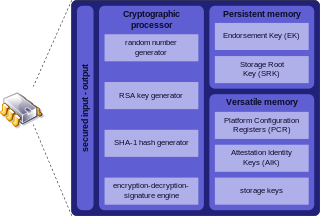
Digital Equipment Corporation, using the trademark Digital, was a major American company in the computer industry from the 1960s to the 1990s. The company was co-founded by Ken Olsen and Harlan Anderson in 1957. Olsen was president until he was forced to resign in 1992, after the company had gone into precipitous decline.

IBM PC compatible computers are similar to the original IBM PC, XT, and AT, all from computer giant IBM, that are able to use the same software and expansion cards. Such computers were referred to as PC clones, IBM clones or IBM PC clones. The term "IBM PC compatible" is now a historical description only, since IBM no longer sells personal computers after it sold its personal computer division in 2005 to Chinese technology company Lenovo. The designation "PC", as used in much of personal computer history, has not meant "personal computer" generally, but rather an x86 computer capable of running the same software that a contemporary IBM PC could. The term was initially in contrast to the variety of home computer systems available in the early 1980s, such as the Apple II, TRS-80, and Commodore 64. Later, the term was primarily used in contrast to Apple's Macintosh computers.
Trusted Computing (TC) is a technology developed and promoted by the Trusted Computing Group. The term is taken from the field of trusted systems and has a specialized meaning that is distinct from the field of confidential computing. With Trusted Computing, the computer will consistently behave in expected ways, and those behaviors will be enforced by computer hardware and software. Enforcing this behavior is achieved by loading the hardware with a unique encryption key that is inaccessible to the rest of the system and the owner.

The Next-Generation Secure Computing Base is a software architecture designed by Microsoft which claimed to provide users of the Windows operating system with better privacy, security, and system integrity. NGSCB was the result of years of research and development within Microsoft to create a secure computing solution that equaled the security of closed platforms such as set-top boxes while simultaneously preserving the backward compatibility, flexibility, and openness of the Windows operating system. Microsoft's primary stated objective with NGSCB was to "protect software from software."

A secure cryptoprocessor is a dedicated computer-on-a-chip or microprocessor for carrying out cryptographic operations, embedded in a packaging with multiple physical security measures, which give it a degree of tamper resistance. Unlike cryptographic processors that output decrypted data onto a bus in a secure environment, a secure cryptoprocessor does not output decrypted data or decrypted program instructions in an environment where security cannot always be maintained.

Wintel is the partnership of Microsoft Windows and Intel producing personal computers using Intel x86-compatible processors running Microsoft Windows.

InfiniBand (IB) is a computer networking communications standard used in high-performance computing that features very high throughput and very low latency. It is used for data interconnect both among and within computers. InfiniBand is also used as either a direct or switched interconnect between servers and storage systems, as well as an interconnect between storage systems. It is designed to be scalable and uses a switched fabric network topology. By 2014, it was the most commonly used interconnect in the TOP500 list of supercomputers, until about 2016.
The Organization for the Advancement of Structured Information Standards is a nonprofit consortium that works on the development, convergence, and adoption of open standards for cybersecurity, blockchain, Internet of things (IoT), emergency management, cloud computing, legal data exchange, energy, content technologies, and other areas.
An open standard is a standard that is openly accessible and usable by anyone. It is also a common prerequisite that open standards use an open license that provides for extensibility. Typically, anybody can participate in their development due to their inherently open nature. There is no single definition, and interpretations vary with usage. Good examples of open standards include the GSM, 4G and 5G standards that allow most modern mobile phones to work world-wide.

C99 is an informal name for ISO/IEC 9899:1999, a past version of the C programming language standard. It extends the previous version (C90) with new features for the language and the standard library, and helps implementations make better use of available computer hardware, such as IEEE 754-1985 floating-point arithmetic, and compiler technology. The C11 version of the C programming language standard, published in 2011, replaces C99.

Unified Extensible Firmware Interface is a specification that defines the architecture of the platform firmware used for booting the computer hardware and its interface for interaction with the operating system. Examples of firmware that implement the specification are AMI Aptio, Phoenix SecureCore, TianoCore EDK II, InsydeH2O. UEFI replaces the BIOS which was present in the boot ROM of all personal computers that are IBM PC compatible, although it can provide backwards compatibility with the BIOS using CSM booting. Intel developed the original Extensible Firmware Interface (EFI) specification. Some of the EFI's practices and data formats mirror those of Microsoft Windows. In 2005, UEFI deprecated EFI 1.10.
The Advanced Computing Environment (ACE) was defined by an industry consortium in the early 1990s to be the next generation commodity computing platform, the successor to personal computers based on Intel's 32-bit instruction set architecture. The effort found little support in the market and dissolved due to infighting within the group and a lack of sales.

Trusted Platform Module is an international standard for a secure cryptoprocessor, a dedicated microcontroller designed to secure hardware through integrated cryptographic keys. The term can also refer to a chip conforming to the standard.
Intel Trusted Execution Technology is a computer hardware technology of which the primary goals are:

Peter Nicholas Biddle is a software evangelist from the United States. His primary fields of interest include content distribution, secure computing, and encryption.

Intel Active Management Technology (AMT) is hardware and firmware for remote out-of-band management of select business computers, running on the Intel Management Engine, a microprocessor subsystem not exposed to the user, intended for monitoring, maintenance, updating, and repairing systems. Out-of-band (OOB) or hardware-based management is different from software-based management and software management agents.
Direct Anonymous Attestation (DAA) is a cryptographic primitive which enables remote authentication of a trusted computer whilst preserving privacy of the platform's user. The protocol has been adopted by the Trusted Computing Group (TCG) in the latest version of its Trusted Platform Module (TPM) specification to address privacy concerns. ISO/IEC 20008 specifies DAA, as well, and Intel's Enhanced Privacy ID (EPID) 2.0 implementation for microprocessors is available for licensing RAND-Z along with an open source SDK.
The following outline is provided as an overview of and topical guide to computing:
InstantGo, also known as InstantOn or Modern Standby, is a Microsoft specification for Windows 8 hardware and software that aims to bring smartphone-type power management capabilities to the PC platform, as well as increasing physical security.
Enhanced Privacy ID (EPID) is Intel Corporation's recommended algorithm for attestation of a trusted system while preserving privacy. It has been incorporated in several Intel chipsets since 2008 and Intel processors since 2011. At RSAC 2016 Intel disclosed that it has shipped over 2.4B EPID keys since 2008. EPID complies with international standards ISO/IEC 20008 / 20009, and the Trusted Computing Group (TCG) TPM 2.0 for authentication. Intel contributed EPID intellectual property to ISO/IEC under RAND-Z terms. Intel is recommending that EPID become the standard across the industry for use in authentication of devices in the Internet of Things (IoT) and in December 2014 announced that it was licensing the technology to third-party chip makers to broadly enable its use.










